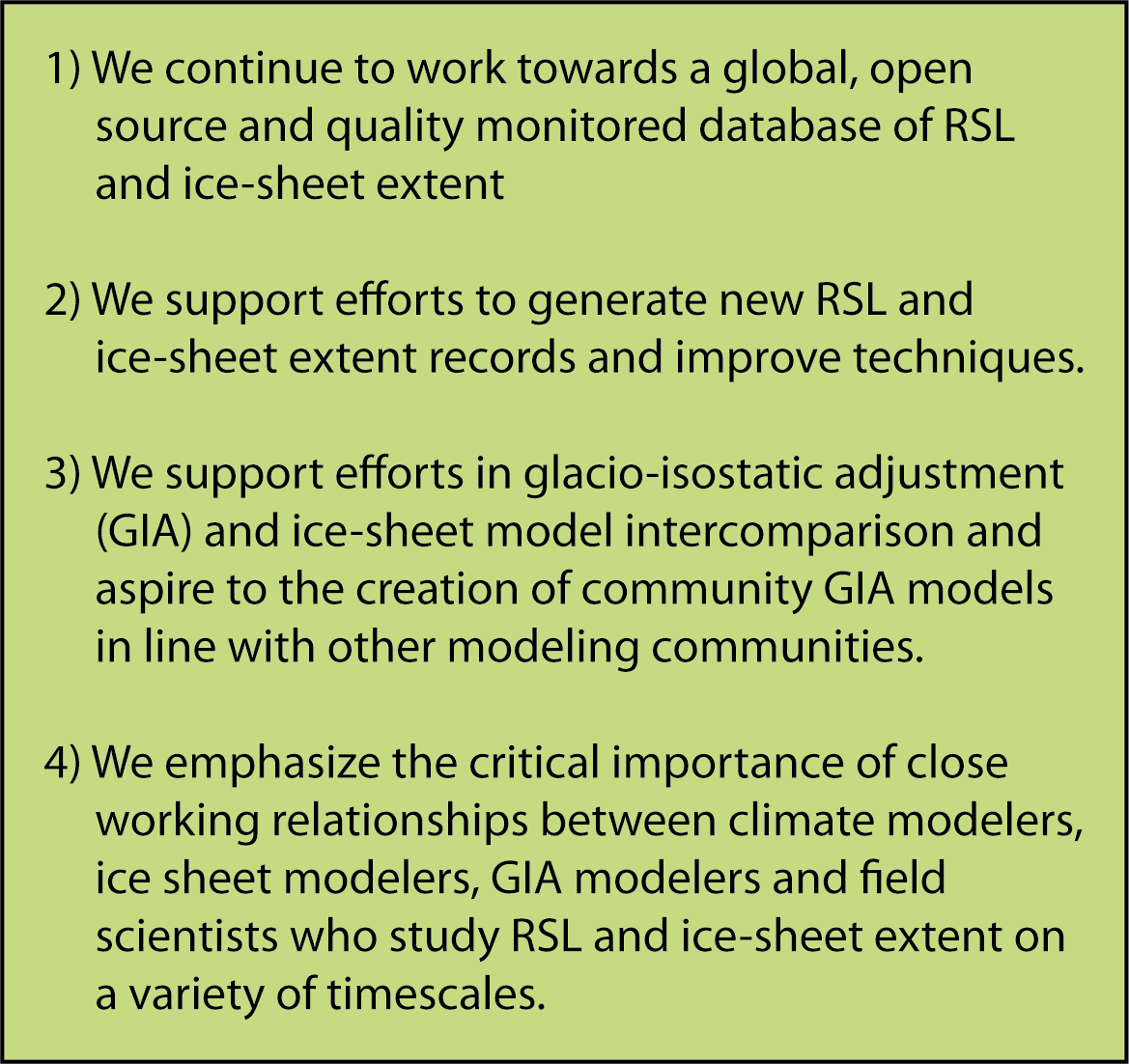- Home
- Publications
- PAGES Magazine
- Relative Sea Level, Ice Sheets and Isostasy Past, Present and Future: Understanding The Implications For Human Populations
Relative sea level, ice sheets and isostasy past, present and future: Understanding the implications for human populations
Andersen MB & Siddall M
PAGES news
19(2)
87-88
2011
Morten B. Andersen and Mark Siddall
Department of Earth Sciences, University of Bristol, UK; mark.siddall bristol.ac.uk
bristol.ac.uk
3rd PALSEA Workshop, Bristol, UK, 20-24 September 2010
 |
|
Table 1: 3rd PALSEA Workshop statements. These statements form the core framework for the continuing effort of the PALSEA workgroup. |
The joint PAGES-IMAGES Working Group “PALSEA” (Paleo-constraints on sea-level rise; www.climate.unibe.ch/~siddall/working_group.html) aims to obtain information on climate and sea-level change during the Quaternary period with a multi-disciplinary approach. A better understanding of the relationship between climate, ice-sheet dynamics and sea level is critical for projections of future sea level rise expected from global warming and cannot be achieved using the instrumental record alone. The 3rd PALSEA workshop Relative sea level, ice sheets and isostasy past, present and future (understanding the implications for human populations) was held at University of Bristol.
The workshop was internationally attended by 80 participators from a wide range of sea‐level related research areas including ice sheet and climate modelers, geophysicists with expertise in glacial‐isostatic adjustment, field scientists engaged in reconstruction of ice-sheet extent and relative sea levels, and marine archeologists. Support was provided by PAGES, IMAGES, the Worldwide Universities Network, UK-Integrated Ocean Drilling Program and the University of Bristol. Scientific presentations and discussions were organized into broad themes of: (1) Predicting future sea-level and ice-sheet evolution (2) Sea level and ice sheets during Termination I (3) Ice sheets: observation and modeling (4) Sea level and ice sheets entering and during warm periods (5) Sea levels and ice sheets during the Holocene (6) panel discussions focused on deliverables and future funding strategies.
Among the variety of topics discussed was sea level and ice-sheet evolution following Termination I, including comparisons of records of the last deglacial sea-level rise (e.g., from Sunda shelf and Tahiti corals) and meltwater pulse events (MWP). Specific attention was given to the character of the MWP 1b event, which was suggested to have been very small (if it existed at all) to be consistent with near field data. Ideally, a combination of existing and new observable data on MWPs, with well-defined error estimates, coupled with glacio-isotstatic adjustment (GIA) modeling would help to quantify MWPs more accurately, which is key to the understanding of ice-sheet extent and dynamics. For example, for MWP 1a, there is a discrepancy between glaciological data and glacio‐eustatic modeling on where the melt water was sourced (Antarctica, Northern Hemisphere or both). In order to address this problem, improved cross-disciplinary communication between data and model specialists is essential. Another important topic addressed was the stability of ice sheets during warm periods and in particular over the last 2000 years. Despite considerable attention, there remain many unanswered questions, particularly concerning sea level and ice-volume stability in relation to insolation forcing during warm periods. Research on ice-sheet stability during present and past warm climates will benefit our general understanding of ice-sheet dynamics of both the Antarctic and Greenland ice sheets. Improved sea level estimates for the Pliocene Warm Period (when ice sheets were greatly reduced), provides another way to address this issue and will be the focus of further research within the PLIOMAX project (Raymo et al., 2009).
Because the main focus points of the PALSEA Working Group is to tightly integrate the different communities working on research themes related to reconstruct past and predict future sea-level fluctuations, a set of key workshop statements was formulated (Table 1).
references

